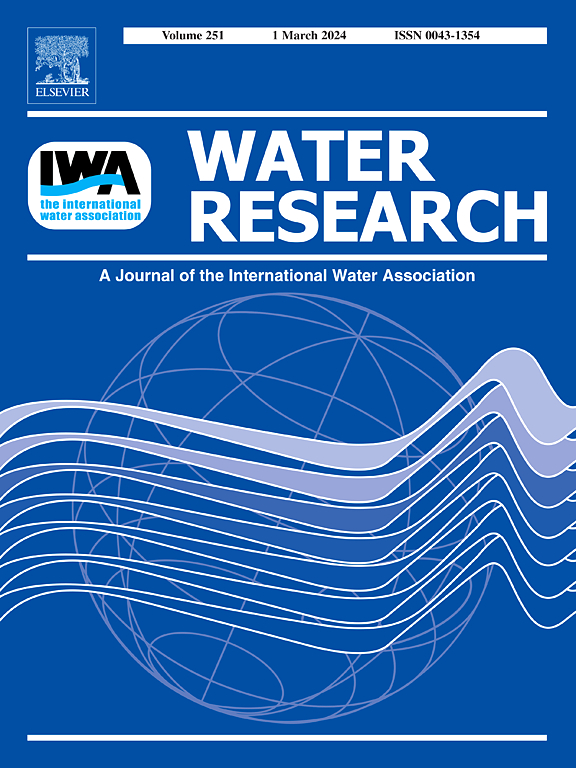dnra增强的MABR-PN/A混合系统中氧化亚氮和残余硝酸盐的协同抑制
IF 12.4
1区 环境科学与生态学
Q1 ENGINEERING, ENVIRONMENTAL
引用次数: 0
摘要
为了解决MABR耦合部分硝化-厌氧氨氧化(MABR- pn /A)过程中NO3−-N的产生和积累问题,研究了铁碳(IC)介导的NO3−-N分化系统(IC-MABR- pn /A)。结果表明,在不添加厌氧氨氧化菌(AnAOB)的情况下,IC-MABR-PN促进了NO3−-N的异化(比MABR-PN降低了11.86±0.68 mg/L),这是由于IC刺激下亚硝酸盐异化酶(Nrf)的积累和对NO2−-N的竞争强于亚硝酸盐还原酶(Nir) (2.23 log2)。IC同时增强了IC-MABR-PN的反硝化作用(与MABR-PN相比,TN减少6.48±0.28 mg/L, N2O积累减少37.9±5.8 mg/L)。值得注意的是,当AnAOB加入IC-MABR-PN时,IC-MABR-PN/A中的肼合酶(Hzs, 1.83 log2)比一氧化氮还原酶(Nor, -1.96 log2)表现出更强的结合亲和力,有利于IC-MABR-PN/A中的NO竞争,抑制N2O途径(将其排放量减少到IC-MABR-PN的九分之一)。厌氧氨氧化进一步调节生物膜疏水性,以减轻界面排斥和铁碳诱导的压实,增强氮转移。该研究通过ic介导的NO3−-N异化和厌氧氨氧化竞争实现了NO3−-N的协同去除和N2O的还原。本文章由计算机程序翻译,如有差异,请以英文原文为准。

Synergistic suppression of nitrous oxide and residual nitrate in DNRA-enhanced MABR-PN/A hybrid systems
To resolve NO3−-N production and accumulation in MABR coupled partial nitrification-Anammox (MABR-PN/A) for autotrophic nitrogen removal enhancement, an iron-carbon (IC) mediated NO3−-N dissimilation system (IC-MABR-PN/A) was developed. Results indicate that when anaerobic ammonia oxidizing bacteria (AnAOB) are not added, IC-MABR-PN enhanced NO3−-N dissimilation (reducing NO3−-N by 11.86±0.68 mg/L vs. MABR-PN) due to nitrite dissimilation enzyme (Nrf) accumulation and stronger competition for NO2−-N compared to nitrite reductase (Nir) under IC stimulation (2.23 log2). Besides, IC concurrently strengthened denitrification in IC-MABR-PN (TN decreased by 6.48±0.28 mg/L but N2O accumulation by 37.9 ± 5.8 μg/L vs. MABR-PN). Notably, when AnAOB was added to IC-MABR-PN, hydrazine synthase (Hzs, 1.83 log2) in IC-MABR-PN/A exhibited stronger binding affinity than nitric oxide reductase (Nor, -1.96 log2), favoring NO competition in IC-MABR-PN/A and suppressing N2O pathways (reducing its emissions to one-ninth of that in IC-MABR-PN). Anammox further regulated biofilm hydrophobicity to mitigate interfacial repulsion and iron-carbon-induced compaction, enhancing nitrogen transfer. The study achieved synergistic NO3−-N removal and N2O reduction through IC-mediated NO3−-N dissimilation and Anammox competition.
求助全文
通过发布文献求助,成功后即可免费获取论文全文。
去求助
来源期刊

Water Research
环境科学-工程:环境
CiteScore
20.80
自引率
9.40%
发文量
1307
审稿时长
38 days
期刊介绍:
Water Research, along with its open access companion journal Water Research X, serves as a platform for publishing original research papers covering various aspects of the science and technology related to the anthropogenic water cycle, water quality, and its management worldwide. The audience targeted by the journal comprises biologists, chemical engineers, chemists, civil engineers, environmental engineers, limnologists, and microbiologists. The scope of the journal include:
•Treatment processes for water and wastewaters (municipal, agricultural, industrial, and on-site treatment), including resource recovery and residuals management;
•Urban hydrology including sewer systems, stormwater management, and green infrastructure;
•Drinking water treatment and distribution;
•Potable and non-potable water reuse;
•Sanitation, public health, and risk assessment;
•Anaerobic digestion, solid and hazardous waste management, including source characterization and the effects and control of leachates and gaseous emissions;
•Contaminants (chemical, microbial, anthropogenic particles such as nanoparticles or microplastics) and related water quality sensing, monitoring, fate, and assessment;
•Anthropogenic impacts on inland, tidal, coastal and urban waters, focusing on surface and ground waters, and point and non-point sources of pollution;
•Environmental restoration, linked to surface water, groundwater and groundwater remediation;
•Analysis of the interfaces between sediments and water, and between water and atmosphere, focusing specifically on anthropogenic impacts;
•Mathematical modelling, systems analysis, machine learning, and beneficial use of big data related to the anthropogenic water cycle;
•Socio-economic, policy, and regulations studies.
 求助内容:
求助内容: 应助结果提醒方式:
应助结果提醒方式:


